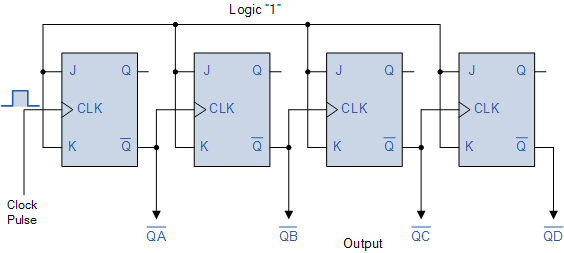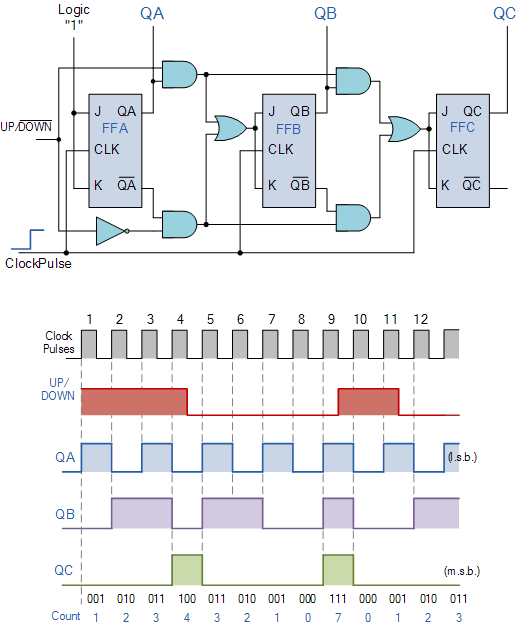Theoretical Paper
- Computer Organization
- Data Structure
- Digital Electronics
- Object Oriented Programming
- Discrete Mathematics
- Graph Theory
- Operating Systems
- Software Engineering
- Computer Graphics
- Database Management System
- Operation Research
- Computer Networking
- Image Processing
- Internet Technologies
- Micro Processor
- E-Commerce & ERP
Practical Paper
Industrial Training
Binary Count Down Counter
As well as counting “up” from zero and increasing or incrementing to some preset value, it is sometimes necessary to count “down” from a predetermined value to zero and to produce an output that activates when the zero count or other pre-set value is reached. This type of counter is normally referred to as a Down Counter, (CTD).
In a Binary or BCD down counter, the count decreases by one for each external clock pulse from some preset value. Special dual purpose IC’s such as the TTL 74LS193 or CMOS CD4510 are 4-bit binary Up or Down counters which have an additional input pin to select either the up or down count mode.
4-bit Count Down Counter

In the 4-bit counter above the output of each flip-flop changes state on the falling edge (1-to-0 transition) of the CLK input which is triggered by the Q output of the previous flip-flop, rather than by the Q output as in the up counter configuration. As a result, each flip-flop will change state when the previous one changes from 0 to 1 at its output, instead of changing from 1 to 0.
Bidirectional Counter
Both Synchronous and Asynchronous counters are capable of counting “Up” or counting “Down”, but their is another more “Universal” type of counter that can count in both directions either Up or Down depending on the state of their input control pin and these are known as Bidirectional Counters.
Bidirectional counters, also known as Up/Down Counters, are capable of counting in either direction through any given count sequence and they can be reversed at any point within their count sequence by using an additional control input as shown below.
Synchronous 3-bit Up/Down Counter

The circuit above is of a simple 3-bit Up/Down synchronous counter using JK flip-flops configured to operate as toggle or T-type flip-flops giving a maximum count of zero (000) to seven (111) and back to zero again. Then the 3-Bit counter advances upward in sequence (0,1,2,3,4,5,6,7) or downwards in reverse sequence (7,6,5,4,3,2,1,0).
Generally most bidirectional counter chips can be made to change their count direction either up or down at any point within their counting sequence. This is achieved by using an additional input pin which determines the direction of the count, either Up or Down and the timing diagram gives an example of the counters operation as this Up/Down input changes state.
Nowadays, both up and down counters are incorporated into single IC that is fully programmable to count in both an “Up” and a “Down” direction from any preset value producing a complete Bidirectional Counter chip. Common chips available are the 74HC190 4-bit BCD decade Up/Down counter, the 74F569 is a fully synchronous Up/Down binary counter and the CMOS 4029 4-bit Synchronous Up/Down counter.

